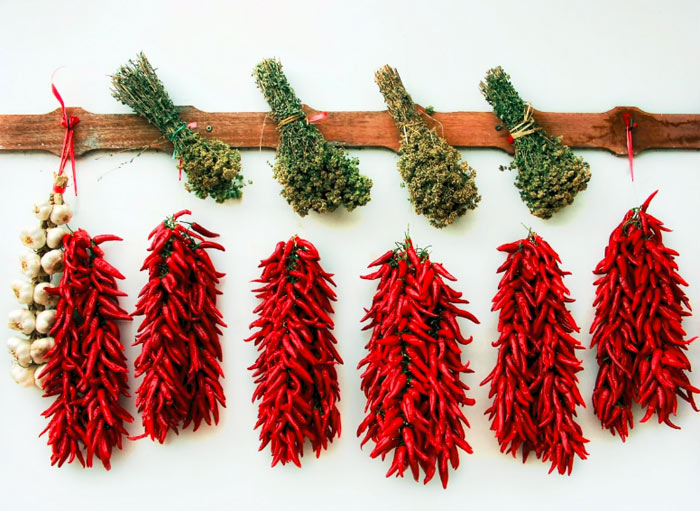6 Essential Herbs of Italian Cuisine
Herbs and spices have been used historically by cultures all over the world for their health benefits as well as to enhance the flavor of the dish. Italian cuisine is no exception. Italian food is known all over for its expert incorporation of aromatic herbs to fortify and enhance the flavor of any meal. It’s probably safe to say that when it comes to Italian food, the seasonings are just as important as any other ingredient.

In the kitchens of Italian restaurants, and in other restaurants that specialize in fine Italian cuisine, there is no shortage of unique Italian herbs and spices that make Italian flavor so iconic.
In this article, we will discuss some of the most common herbs that you will find in any Italian kitchen.
1. Rosemary
Rosemary is an herb in the mint family Lamiaceae . Rosmarinus officinalis is a small evergreen shrub whose 1-inch leaves resemble curved pine needles. It takes its name from the combined Latin words ros, and marinus, meaning “dew of the sea.” However, medieval legend makes the claim that the name of the plant is rooted in Biblical folklore
Rosemary is commonly used as a flavoring for various meats including, beef, lamb, veal and pork, and was historically used as a condiment for salt-cured meats. Especially good as a marinade ingredient for poultry and fish, rosemary has Rosemary has a tea-like aroma and a piney flavor that accompanies citrus and savory flavors quite nicely
2. Parsley
Parsley, or prezzemolo, in Italian, is one of the most commonly used herbs in Italian cooking. Parsley is a commonly used ingredient in seafood and vegetable sauces, as well as in most pasta dishes and soups. It is well loved in Italian cuisine for the way it complements spicy flavors. Its health benefits include vitamins A, B, and C, as well as iron, iodine, and magnesium. Parsley is a great breath freshener – which is why it is commonly found paired with garlic!
3. Sage
Sage is a shrubby, perennial plant that grows to about 2-3 feet tall. Its Foliage is gray-green with a velvety texture. Sage has been used for centuries for not only it’s flavor enhancing qualities, but also for its apparent antimicrobial properties, among other health benefits. Sage is commonly used in fish, pork and poultry dishes, as well as in some martinis you’d find in a Las Vegas night club.
4. Oregano
Oregano, or a flowering plant in the mint family, Lamiaceae. It is native to temperate Western and Southwestern Eurasia and the Mediterranean region. Sometimes called wild marjoram, Oregano is described as having a strongly aromatic, camphoraceous aroma and a slightly bitter, pungent flavor.
Most commonly found as a seasoning in tomato sauces, oregano has become synonymous in the United States with “pizza flavor”, oregano is also used as in soups, vegetable dishes, sausages and other meat dishes.
5. Thyme
Known in Italian as timo, thyme is an aromatic herb that is related to mint. It grows to a height of about twelve to fifteen inches and has small rounded leaves on woody stalks with pink flowers. Though they share a common name, this herb is not the same species as wild thyme.
Today the plant is commonly found throughout much of the North American continent, but it originated in the southern Mediterranean. This herb derives its name from the Greek word thumos meaning “courage”.
Thyme has a subtle, dry aroma and a slightly minty flavor. is often included in seasoning blends for poultry and stuffing and also commonly used ingredient in fish sauces, chowders, and soups. It goes incredibly well with lamb and veal as well as with eggs, custards, and croquettes.
6. Peperoncino
Peperoncino, better known as hot peppers, add spice and flavor not only to the simple foods of southern Italy but for true lovers of spice, it can be almost addictive.
Commonly used to add spice and flavor to fish and vegetables, pasta sauces, soups, and stews, as well as egg dishes. As a general rule, peperoncino is not recommended for delicate and creamy preparations but is more suitable for robust sauces and recipes. A bit of peperoncino can really enhance a good bolognese as well, adding a whole new dimension to a classic preparation.
In southern Italy, ground chili peppers are sometimes added to salumi and cheeses, and it is not uncommon to find chili infused oil on every table.
Final Thoughts
Italian food is well loved throughout the world for its sumptuous flavors and delicate balance of textures. It simply wouldn’t be what we know it as today without these wonderful aroma imparted to it by these pungent seasonings. What are your favorite Italian herbs and ingredients? Leave us a comment with your thoughts in the section below.









